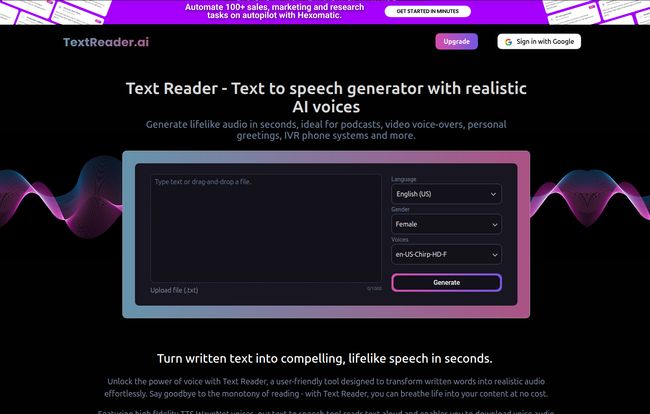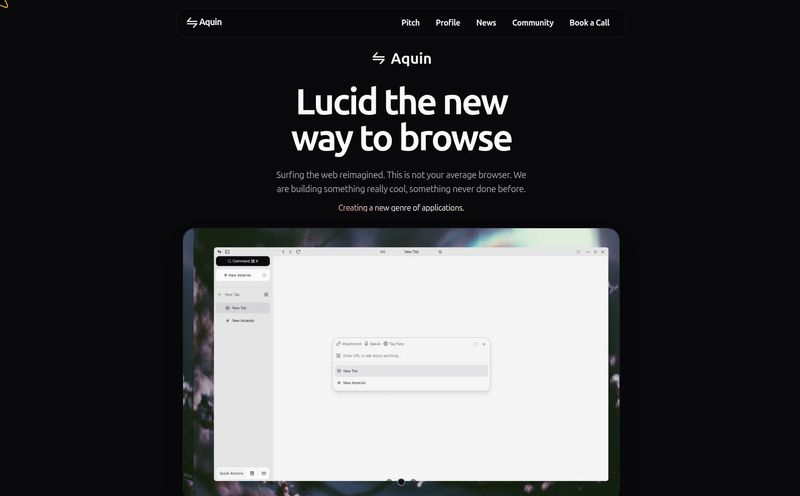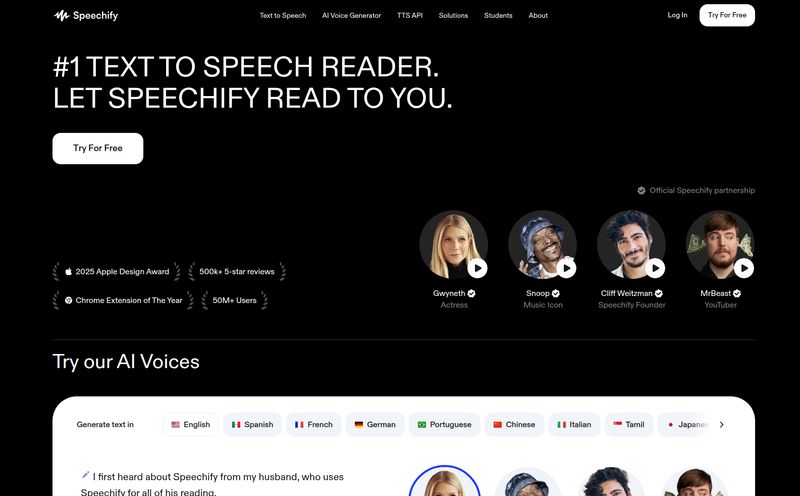If you’re a content creator, a marketer, or even just someone trying to make a slick presentation, you’ve probably faced the voice-over dilemma. You either spend hours recording yourself, hating the sound of your own voice (just me?), or you shell out a small fortune for a professional voice artist. For a while, the third option—text-to-speech—was a joke. The robotic, monotone voices were good for a laugh but terrible for business.
But things change. Fast. I've been keeping my eye on the AI voice space for a few years now, and the leap in quality is staggering. Which brings me to the tool I've been playing with recently: Text Reader. It claims to generate lifelike audio with realistic AI voices, and I was, to be honest, skeptical. But after putting it through its paces, I have some thoughts. A lot of them, actually.
So, What Exactly is Text Reader?
At its core, Text Reader is a text-to-speech (TTS) generator. You give it text, it gives you back an MP3 audio file of that text being spoken. Simple, right? But the magic is in the how. It’s not your 2010-era GPS voice. The platform uses what they call “high-fidelity TTS WaveNet voices,” which, for the less nerdy among us, is a fancy way of saying the AI is sophisticated enough to pick up on more human-like intonations and rhythms. It’s designed to be a one-stop-shop for creating audio for podcasts, video narrations, customer service systems, and even personal stuff like birthday messages.
Essentially, it’s a tool that wants to automate one of the most time-consuming parts of content creation and save you a bucket of money in the process. A bold claim. Let’s see if it holds up.
The Real Reasons to Go Mic-less with AI Voices
Why would you hand over your script to a machine? I get the hesitation. But the advantages are pretty compelling, especially once you try it.
Cost and Time: The Two Hurdles Every Creator Faces
Hiring a voice actor is expensive. We're talking hundreds of dollars for even short scripts. And the back-and-forth for edits and retakes? That’s not just money, that's time. With a tool like Text Reader, the cost is a fraction of that, and the turnaround is… well, seconds. You paste your script, click a button, and you have your audio. Need a change? Just edit the text and regenerate. No awkward emails asking for a retake because you decided to change one word. This alone is a massive workflow improvement.
The Unbeatable Power of Consistency
Ever record a voice-over over two different days? The energy is different. The room tone changes. Maybe you have a slight cold. The end result sounds patchy and unprofessional. AI voices eliminate this entirely. Every line is delivered with the exact same tone, pacing, and quality. It’s the kind of consistency that’s incredibly difficult for a human to replicate perfectly, especially on a tight budget. Plus, the AI doesn't say "um" or need a glass of water. A small but significant victory.
Go Global Without Leaving Your Desk
This one's a big deal. The platform boasts support for over 50 languages and variants. Think about that. You can create a marketing video and then, with minimal effort, produce versions for Spanish, German, and Japanese audiences. The cost and logistical nightmare of hiring native speakers for each language is immense. An AI voice generator makes global content strategy accessible to small creators and businesses, not just giant corporations. That's democratization of content, right there.
Putting Text Reader Through Its Paces
Alright, talk is cheap. How does it actually work? I found the interface to be refreshingly simple. It’s basically a box where you type or paste your text, a couple of dropdown menus to select your language and voice (they have male and female options), and a big button to make it happen. No confusing menus or a steep learning curve. You can literally go from landing on the page to downloading your first audio file in under a minute.
You just type something in, pick a voice like 'en-US-Standard-F', and hit generate. A few seconds later, a playable audio file appears, ready for download. It's almost anticlimactic in its simplicity.

Visit Text Reader
Who Is This Tool Actually For?
I can see a ton of people getting great use out of this. It's not a one-size-fits-all solution, but it’s surprisingly versatile.
Podcasters and YouTubers on a Budget
If you're starting a podcast or a YouTube channel, audio quality is king. But you might not have the budget for a pro mic or the confidence to be the voice of your own channel. Text Reader is a fantastic bridge. You can produce clean, clear narration for explainer videos, documentary-style content, or even podcast intros and outros without breaking the bank. It keeps your production value high while you focus on the content itself.
Educators and Corporate Trainers
Imagine creating e-learning modules. Reading walls of text can be draining for students or employees. Converting that text into audio provides an alternative way to consume the material. It’s great for accessibility and for making learning materials more engaging. Instead of just reading a case study, trainees can listen to it. It’s a simple change that can make a big difference in comprehension.
Smart Marketers and Businesses
From turning blog posts into audio articles (hello, increased engagement!) to creating professional-sounding IVR and phone answering systems, the commercial applications are obvious. You can quickly create audio for social media ads, product demos, or internal announcements. It projects a level of professionalism that might otherwise be out of reach for a small team.
Let's Talk About the Price Tag
Okay, the money part. While there is some limited free usage to test the waters, the real power is in the pro plans. And honestly, the pricing seems very reasonable for what you get.
| Plan | Price | Key Features |
|---|---|---|
| Pro Monthly | $18 / month | 3 hours of voice generation per month, 50+ languages, unlimited downloads. |
| Pro Annual | $15 / month (billed annually) | 36 hours of voice generation per year, 50+ languages, unlimited downloads. |
My take? If you're going to use this regularly—say, for a weekly YouTube video or podcast—the annual plan is a fantastic deal. You're effectively paying $15 for what could be hours of studio time and talent fees. For sporadic projects, the monthly plan offers great flexibility. It's a tiny investment for the production value it adds.
The AI Elephant in the Room: Let's Be Realistic
Is it perfect? Of course not. And any review that tells you otherwise is selling you something. The biggest limitation is what I call the “subtlety gap.” While these AI voices are amazing, they can sometimes struggle with complex emotions. Sarcasm, deep pathos, bubbling excitement... a human actor still has the edge there. The AI is brilliant at neutral, informative, and professional narration. But if your script requires a nuanced, emotional performance, you might still want to hire a human.
Think of it as a tool in your arsenal. It's not a replacement for every voice-over need, but it's an incredible, cost-effective solution for about 90% of them. You have to know when to use it.
FAQs About Text Reader
1. How realistic do the AI voices actually sound?
They sound surprisingly natural for most narration tasks. Thanks to technologies like WaveNet, they avoid the classic robotic tone. They're great for explainers, educational content, and corporate videos. They might not win an Oscar for dramatic performance, but they're clear, professional, and very listenable.
2. Can I use the audio for commercial projects like YouTube or ads?
Yes, that's one of the main selling points. With a Pro plan, you can generate audio for a wide range of commercial uses, including video voice-overs, podcasts, and even IVR phone systems for your business.
3. How hard is it to use? Do I need to be a tech expert?
Not at all. The interface is incredibly straightforward. If you can copy and paste text and click a button, you have all the technical skills you need. It’s designed for simplicity and speed.
4. What happens if I need to make a change to the script?
This is where it shines. You just go back to the text box, make your edits, and regenerate the audio in seconds. It's infinitely faster and easier than coordinating with a human voice actor for revisions.
5. Is the Pro plan worth the money?
If you create content that requires voice-overs more than once or twice a year, absolutely. The amount of time and money you save compared to hiring talent or struggling with your own recordings makes the subscription a very small price to pay for the boost in productivity and quality.
The Final Word on Text Reader
So, is Text Reader a game-changer? For a huge number of creators, I think it is. It's not about replacing human creativity but about augmenting it. It handles the grunt work of creating clean, professional audio, freeing you up to focus on writing better scripts and creating better content. It lowers the barrier to entry for high-quality production and opens up possibilities, like multilingual content, that were previously out of reach for many.
It’s an impressive, practical, and affordable tool that delivers on its promise. If you’ve been on the fence about AI voices, I'd say give Text Reader a spin. You might be surprised at how quickly it becomes an indispensable part of your creative toolkit. I know I was.



